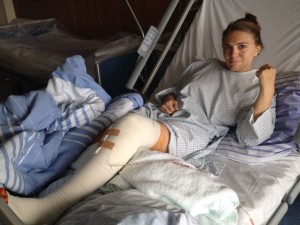Following my travel blog about Nepal, I should mention that I purposely wrote this in chronological order as I started to notice another swelling during my trip. I blamed the increased pain in my knee on the long rides in the car as well as some walking during the day and thus u[on my return to Bangkok I arranged another doctor’s appointment.

My last selfie with long hair
On 1 October 2014, one day before I had to take my flight to Germany for my mother’s 60th birthday and a business trip in Europe, I went for my x-ray in the evening. Again my doctor had this weird look on his face when I returned into his office, and he confessed that it seemed to be like a recurrent tumor. I was sent immediately for an MRI, but at this point I was already not able to straighten my leg and I kept having cramps. This time it was really hard to lie still for 30 minutes; I had tears in my eyes from the cramps and pain.
Then the shocking news: the tumor is bigger, more aggressive and most likely malignant. My head started spinning… and my mind was confused. I had a plane to catch the next morning, I still haven’t packed, and I most likely have cancer. I can only remember single words from the doctor: cancer, chemotherapy, and amputation. My boyfriend immediately made his way to the hospital, and we managed to speak to the doctor again and I was slowly able to think clearly.
The next morning I left Thailand with a very strange feeling. That feeling when you don’t know when you will be back, and I had a gut feeling this may be a very long time. Leaving all my day-to-day belongings behind and my home was weird…
Initially, I tried to pretend all was fine. On the 4th of October we celebrated my mother’s 60th birthday at the “Wasen” (it is like the famous Octoberfest in Munich but this one is in Stuttgart), a long time planned evening. There was nothing that could hinder me to celebrate this special evening with her, my family and their friends.
Two days later I had an appointment with a tumor orthopedic specialist at the Uniklinikum Muenster, which was recommended by my doctor in Bangkok and is considered as the best address in Europe for its limb salvage procedure.

After my biopsy in hospital
An immediate biopsy surgery was initiated where a little bit of tissue was removed to indicate the tumor type. The following two weeks were the worse: waiting for the results. I tried to keep myself busy with work but my mind kept drifting off.
On 20 October 2014 I received the shock diagnosis, it fact it wasn’t really a shock anymore but rather a confirmation of the biggest fear I had: I have an Osteosarcoma. At this point all I could do is to start with chemotherapy as soon as possible.
What is an Osteosarcoma and what type do I actually have?
An Osteosarcoma is a very aggressive malignant (cancerous) bone tumor. The tumor produces immature bone (also known as osteoid), typically in long bones such as the Tibia in my case. There are low-grade or high-grade and also different sub-types of Osteosarcomas, which are all a bit differently composed in terms of its cells.
I have a “Telangiectatic osteosarcoma”, which is a high-grade type, highly malignant and grows very fast also beyond its compartment of origin. Spread of any tumor to another site in the body is referred to as metastasis. Generally, about 80% of the patients with a high-grade osteosarcoma have micrometastasis at the time of diagnosis, those that are not detectable on CT or MRI scans. The two most common sites of spread of osteosarcoma are lung and bone.
In October 2014 there was no sign of metastasis in my lung but a shadow in my pelvic bones was noticed which wasn’t there when I did the nuclear scintigraphy in Bangkok.
So now I ask myself why did I get this? Why did I initially have a benign giant cell tumor and now I have a malignant osteosarcoma?
The composition of cells in both type of tumors are similar (but still different from each other). An osteosarcoma can contain those “giant cells” that are typical in the Giant Cell Tumor. So there are now two possible explanations for this.
- There was a misdiagnosis before the first surgery in Bangkok, as the tissue sample could have been taken from a part that ultimately contained those giant cells and not the cancerous ones (or)
- In very rare cases a benign giant cell tumor can also mutate to an osteosarcoma.
Whilst a giant cell tumor is typical amongst young adults between the age of 20 and 40, an osteosarcoma is more common below the age of 25 and during adolescence when there is a growth push. So again all initially indicated that it was a giant cell tumor but I seem to be one of those rare cases.
By the way did you know that primary bone sarcomas make up less than 0.2% of all cancer cases?
PS: Who is interested to read more about the various types of sarcomas can visit the following useful website: www.sarcomahelp.org